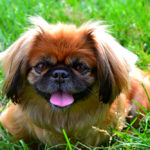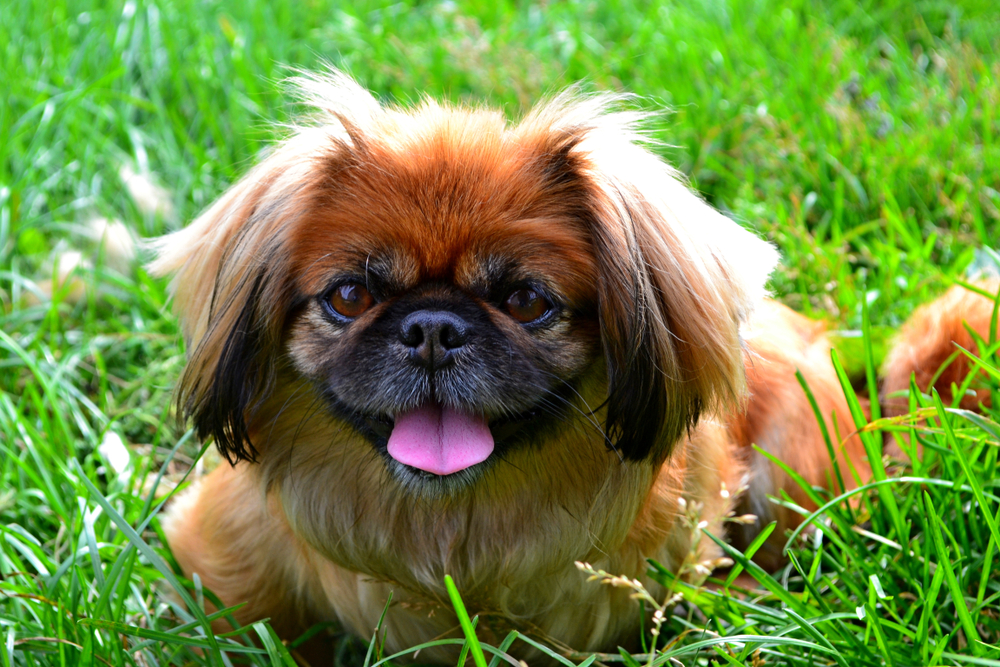So why should you get a Pekingese? Here we guide you through some pros and cons of having a Pekingese, so you will know what to look for, when ready to make the purchase. This breed is a product of thousands of generations of selective breeding for imperial demeanor as well as lionlike appearance and beauty.
It does not look like other breeds, and it does not act like other breeds, nor should it be expected to.
The Pekingese Personality
The Pekingese still plays the role of royal dog with the same calm dignity that it must have displayed in the emperor’s palace. As befitting an object of adulation, the Pekingese is gentle but condescending, and remains aloof with strangers.
This is the public Pekingese—haughty, deliberate, regal, and sedate. But the private Pekingese is another animal entirely. Around its family, the Pekingese is apt to change from court royalty to court jester.
The Wild Side
The Pekingese has some more surprises in store for those who get to know it. First of all, contrary to popular belief, this is no “sissy” lapdog. Even extensive selection for royal demeanor could not erase the natural instinct of the Pekingese to, at times, be just a dog.
The Peke likes nothing better than a jaunt afield, where it will give chase to a rabbit with a fervor that would make any Beagle blush. It also will not hesitate to plunge into a lake, poke its flat face deep into a hole, or subject its magnificent coat to an occasional mudpack and cocklebur beauty treatment. This stately palace dog has a definite wild side.
Courage: In fact, the Pekingese is a tough character. It will not start a fracas, but it will never back down from one. Its courage is virtually boundless. This courageous attitude, coupled with its calm disposition, makes the Pekingese the ideal watchdog.
It does not yap incessantly, or call the alarm to a falling leaf, but when it does bark, its owner can be sure that there is something of which to take note.
Independence: Many dogs are dependent upon their owners, looking to them for guidance at every turn. Not so the Pekingese. It is fiercely independent, and this trait, combined with its indisputably strong will, can be exasperating to the first-time Peke owner.
The Pekingese does not have a stubborn streak; it has a stubborn body. When the Pekingese plants its feet and says “No,” it becomes a canine anchor. Attempts to force it into compliance result in only more determination to have its own way. When it comes to doing nothing, despite all urging to the contrary, the Pekingese is among the unchallenged masters of dogdom.
Intelligence: Pekingese are extremely intelligent dogs but they need intelligent trainers who can mold their training techniques to work with, rather than against, a dog that does not act like most other dogs. Trained correctly, the Pekingese can be an obedient and trustworthy companion; yet it will never be a fawning slave.
Fa mily: As befitting any royalty, the Pekingese does not immediately take to strangers. It is a one-family dog, and does not hesitate to discriminate between family and non-family. Still, with time it will gradually warm up to new acquaintances, and once accepted as friend, it displays undying loyalty and devotion.
mily: As befitting any royalty, the Pekingese does not immediately take to strangers. It is a one-family dog, and does not hesitate to discriminate between family and non-family. Still, with time it will gradually warm up to new acquaintances, and once accepted as friend, it displays undying loyalty and devotion.
Indeed, one of the breed’s great charms is that it requires people to earn its friendship, unlike so many breeds that seem all too eager to abandon their family for the first stranger who throws a ball.
The Pekingese loves its family dearly, but it is not overly demonstrative. Apart from an exuberant greeting, it prefers to honor its loved ones with an occasional kiss, never indiscriminately nor insincerely given. Not a lapdog by nature, the Pekingese will nonetheless acquiesce to sitting in your lap if you ask it nicely.
Although left to its own it would probably prefer to sit very close by your side as an equal, it will trade a slight loss in dignity for a soft caress.
The Pekingese is indeed royalty, and it will never let you forget it. But it is equally willing to appoint its family as royalty as well, and make its home, no matter how humble, an imperial palace.
Pekingese Predispositions
The very traits that make Pekes so appealing can also make them more prone to some health problems.
Brachycephalic syndrome
Pekingese are brachycephalic, which means they have flat faces with short muzzles. This configuration also means they have compacted respiratory systems, which leads to a condition called brachycephalic syndrome.
This condition consists of a group of anatomical abnormalities that may lead to breathing problems ranging from the Peke’s snoring through heat and exercise intolerance to life-threatening breathing difficulties.
Stenotic nares (abnormally small nostrils), which are often seen in brachycephalic syndrome, decrease the amount of air flow when inhaling; severe cases require surgery to enlarge the nostrils. Another common component of brachycepahic syndrome is an elongated soft palate, which can swell and partially obstruct breathing if the dog pants heavily.
Heat
Pekingese are heat-intolerant. Dogs build up heat according to body mass and give off heat according to body surface. The Peke’s heavy body has a minimal amount of body surface compared to body area, and that surface is covered with thick hair, so the body tends to hold heat more than the average dog.
Dogs rid themselves of excess heat by evaporation of surfaces of the tongue and respiratory tract. The Peke’s face, muzzle, and respiratory tract have relatively little surface area available for cooling. Pekes build up heat and can’t shed it, making them at risk of deadly heatstroke in even mild weather.
Pekingese owners must be prepared to shield their dogs from overheating. You must be willing to run the air-conditioning even when it’s not terribly warm, and be prepared with ice packs in the event electricity fails or a car breaks down.
Eye Concerns
Pekingese tend to have fairly prominent eyes, which renders the eye surface more susceptible to scratches and drying. In some Pekes, the eyelids do not close tightly, causing the surface to dry so much that vision is lost. In other Pekes, the hair growing from the fold of skin over the nose touches the eye surface, irritating it and leaving it susceptible to infection.
Wrinkle Dermatitis
The fold of skin overlying the nose can be a source of another problem. If the wrinkled area is allowed to remain moist, the area can become infected. Peke owners must be diligent about keeping the wrinkle clean and dry.

